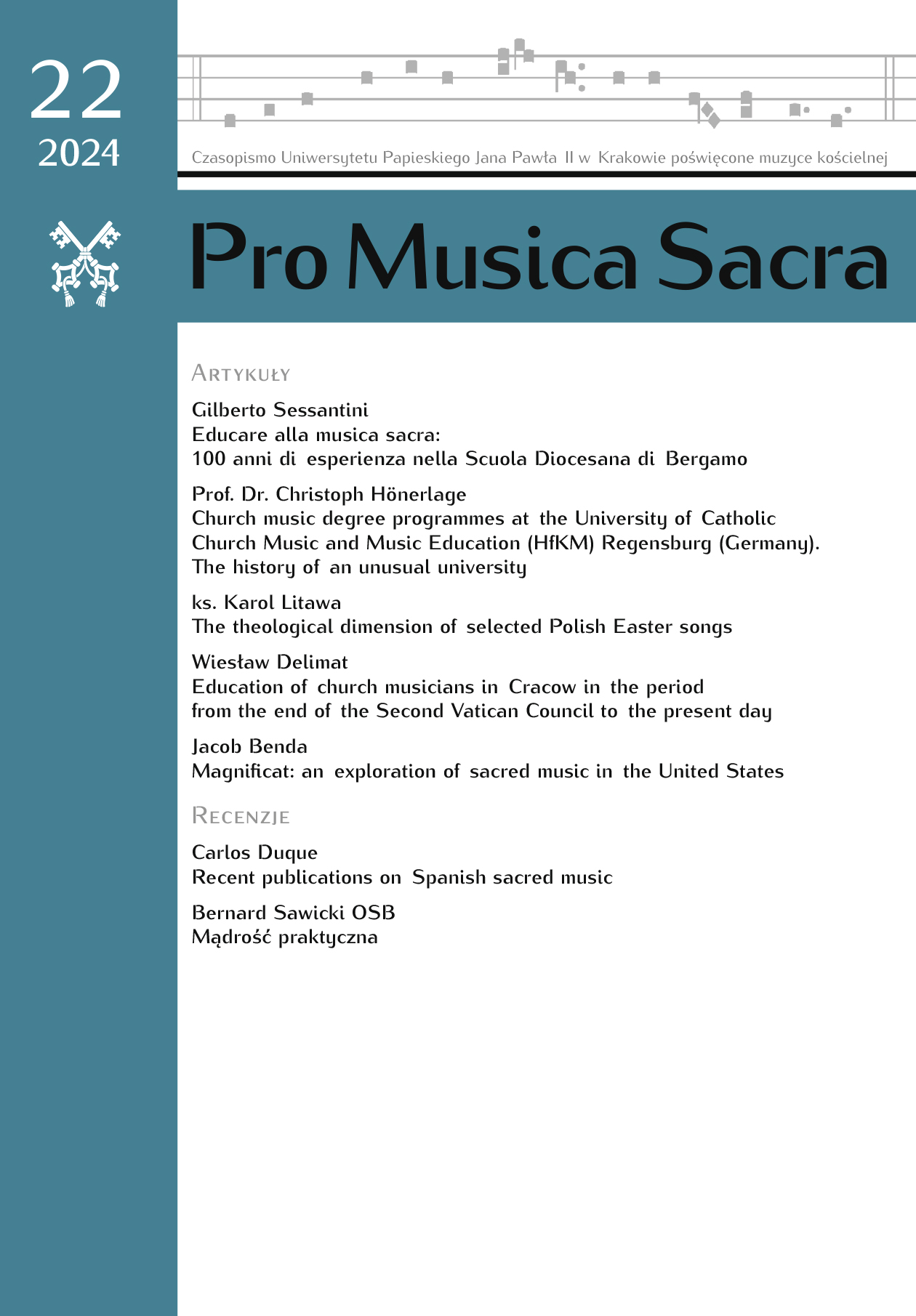Educating sacred music: 100 years of experience in the Diocesan School of Bergamo
DOI:
https://doi.org/10.15633/pms.2201Keywords:
Diocesan school of sacred music of Bergamo, training in sacred music, children’s choirAbstract
The diocesan school of sacred music, today the Accademia Musicale S. Cecilia of Bergamo, turns one hundred years old. In the light of this centuries-old experience, the report, after a brief historical excursus, identifies some key elements of the training in sacred music that it offers today to the parishes of the Diocese of Bergamo. The first and essential element is training in music in general, especially for the new generations. The academy carries out this task through musical preparatory courses, aimed at the youngest (0–6 years), and the children’s choir, aimed at older students (7–12 years). These two educational activities constitute the musical literacy and ear-training course. The second element concerns training in sacred music. It is carried out by specialized teaching of Gregorian chant, choir conducting, liturgical musicology and vocality,
organ. The strong point lies in the convergence of several people and institutions towards this same goal, since they are involved in various capacities, the Cathedral with its organs and its Schola gregoriana, the Basilica of S. Maria Maggiore with its renowned
and historic Cappella musicale, the Bergamo Conservatory. This collaboration network effectively makes the two most important churches of the Diocese also a dual center for the production, education, and promotion of sacred music. What is actually taught in the Academy is what is implemented in these two churches, and given their exemplary nature, it is subsequently implemented in the parishes despite the diversity of the means available.
References
„Annuario della Scuola Primaria di Musica Sacra” 1 (1923–24).
Benedetto XVI, Esortazione apostolica postsinodale Sacramentum Caritatis, 22.02.2007.
Forcella P., Musica e musicisti a Bergamo dalle origini ai contemporanei, Edizioni Villadiseriane, Villa di Serio (BG) 1992.
La Music Learning Theory. Sintesi degli elementi e dei principi fondamentali della teoria dell’apprendimento musicale del bambino secondo Edwin E. Gordon per genitori ed edu catori, a cura di R. Nardozzi, http://bambini-musik.eu/wp-content/uploads/2015/01/LibrettoMusicLearningTheoryITA.pdf (30.03.2024).
Sessantini G., Musica Cathedralis. Organi, Organisti e Maestri di cappella nel Duomo di Bergamo, Edizioni Carrara, Bergamo 2013.
Statuto e Regolamento della Scuola di Musica S. Cecilia di Bergamo 1983.
Downloads
Published
Issue
Section
License

This work is licensed under a Creative Commons Attribution 4.0 International License.
The author declares that he/she owns the copyrights to the work and that they are not limited in the scope covered by this declaration, and that the work is an original work and does not violate the copyrights of others.
The author permits the Pontifical University of John Paul II in Cracow to use the work free of charge, non-exclusively and indefinitely, that is:
- to record and reproduce: produce copies of the work by printing, reprography, magnetic recording and recording with the digital technique;
- to circulate the original or copies on which the work has been recorded (to introduce into circulation, lend or hire of the original or copies, public exhibition, display as well as make the work available to the public in such a manner that everyone can have access to it in a place and at a time of their choice);
- to include the paper in a collective work;
- to grant the Creative Commons Uznanie autorstwa-Użycie niekomercyjne-Bez utworów zależnych 3.0 Poland sublicense by Pontifical University of John Paul II in Cracow
The Pontifical University of John Paul II in Cracow makes the work available on the University's Periodicals Platform owned by the University under the Creative Commons Uznanie autorstwa-Użycie niekomercyjne-Bez utworów zależnych 3.0 Polska licence. This entitles all interested parties to use the work under the following conditions:
- the author and title of the work will be presented,
- the place of publication (the title of the magazine and the URL of the original work published)will be indicated,
- the work will be distributed in a non-commercial manner,
- no derivative works will be created.

